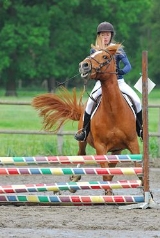
Refusal
Encyclopedia

Equestrianism
Equestrianism more often known as riding, horseback riding or horse riding refers to the skill of riding, driving, or vaulting with horses...
, a refusal is the failure of a horse to jump a fence to which he/she is presented. This includes any stop in forward motion. A run-out is when the horse quickly slides past or "ducks out" of a fence instead of jumping it, without stopping forward motion.
Problems with refusals
Refusals and run-outs are counted against riders in jumping competitions. In show jumpingShow jumping
Show jumping, also known as "stadium jumping," "open jumping," or "jumpers," is a member of a family of English riding equestrian events that also includes dressage, eventing, hunters, and equitation. Jumping classes commonly are seen at horse shows throughout the world, including the Olympics...
and the stadium phase of eventing, a refusal is worth 4 penalty points. In the cross-country phase of eventing
Eventing
Eventing is an equestrian event comprising dressage, cross-country, and show jumping. This event has its roots in a comprehensive cavalry test requiring mastery of several types of riding...
, a refusal counts as 20 penalty points.
Refusals also have the potential to unseat the rider, which may result in rider injury, such as that of Christopher Reeve. Refusals also present the possibility that the horse crashes into the obstacle. In extreme cases, however, it may be best for a horse to refuse rather than jump a fence which he cannot clear, as he might land on the fence, fall on landing, or flip over.
Reasons for refusals
There are several reasons for refusals, therefore a rider must try to identify the problem before reprimanding the horse for his disobedience.Rider-based reasons
- Poor take-off distance, usually due to rider error, which would make it unsafe to jump
- Horse does not have enough power (impulsionImpulsionImpulsion is the pushing power of a horse, which comes from its desire to move powerfully forward with energy. However, speed does not create impulsion, and a rushing horse is more likely to be "flat" than impulsive...
) to safely clear the obstacle, again usually due to rider error - Horse has repeatedly been hit in the mouth or back due to a poor jumping positionJumping positionThe jumping position is a position used by equestrians when jumping over an obstacle. It usually involves what is known as the "forward seat" or "2 point" because the rider has 2 points in contact with the horse; the legs and hands. It was first developed by Captain Federico Caprilli...
of the rider, and now associates jumping with pain - Rider is unsure of jumping the fence, and his or her feelings are transmitted to the horse
- Habit: the horse has learned that it can refuse without consequence, and does so to get out of work
- A solid, colorful, or otherwise different fence may scare the horse
- Horse is "sour," or has been over-jumped and has begun to hate the work
Physical problems
- Back pain, or general soreness
- Dental problems
- Lameness issues, arthritis
- The horse is physically unable to jump the obstacle, due to conformationalEquine conformationEquine conformation evaluates the degree of correctness of a horse's bone structure, musculature, and its body proportions in relation to each other. Undesirable conformation can limit the ability to perform a specific task. Although there are several universal "faults," a horse's conformation is...
issues, insufficient conditioning, or lack of ability.
If a horse has begun to refuse frequently when before it was willing, a veterinary exam can be performed to rule out pain. When pain is ruled out as a factor, rider error is a very common cause for refusals, poor riding may place the horse in a position so that he physically would find it extremely difficult to clear the obstacle (such as too far or too close to the jump). Additionally, riders who do not release over the fence, preventing the horse from stretching down, will hit the horse in the mouth with the bit, and cause pain. If this happens frequently, the horse will associate the pain with the jumping effort itself, and may begin to refuse. Horses that have begun to refuse due to rider error often require retraining.
If a horse is physically unable to jump a fence of a certain size or height, even with the best riding, pushing a horse may result in physical harm to the animal or cause an accident involving both horse and rider.

